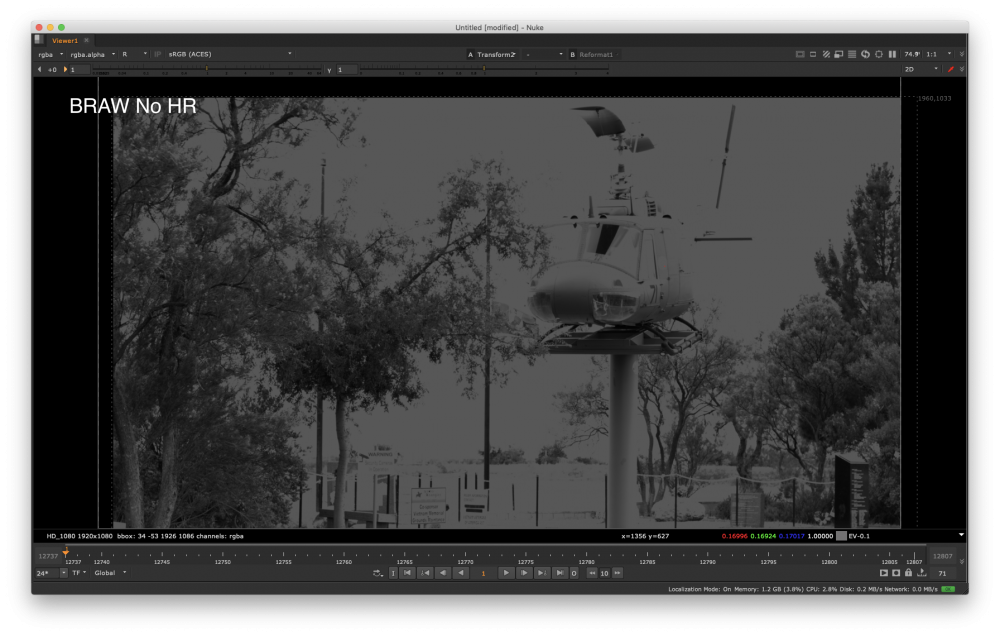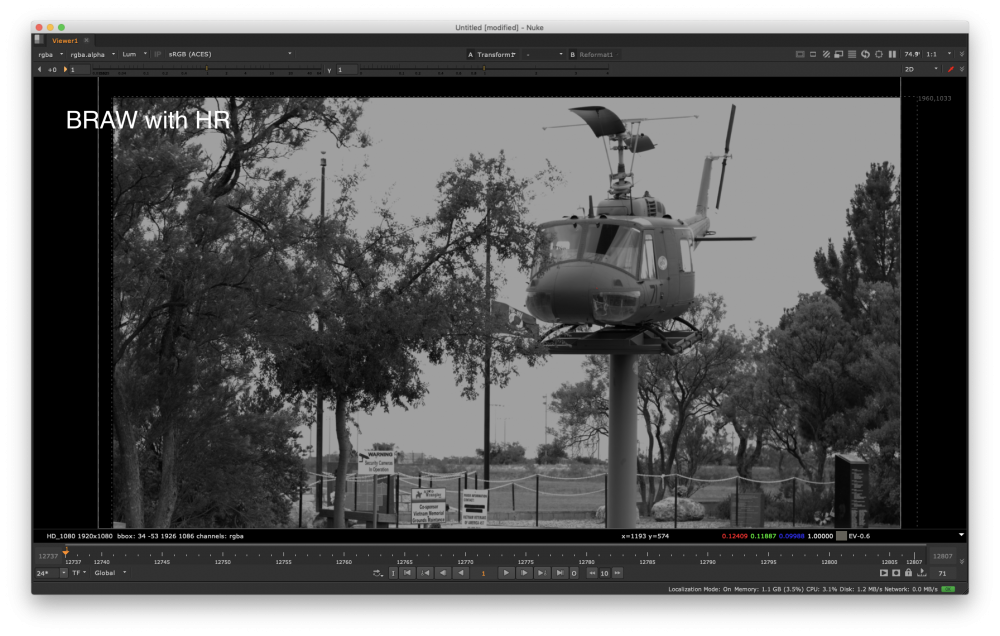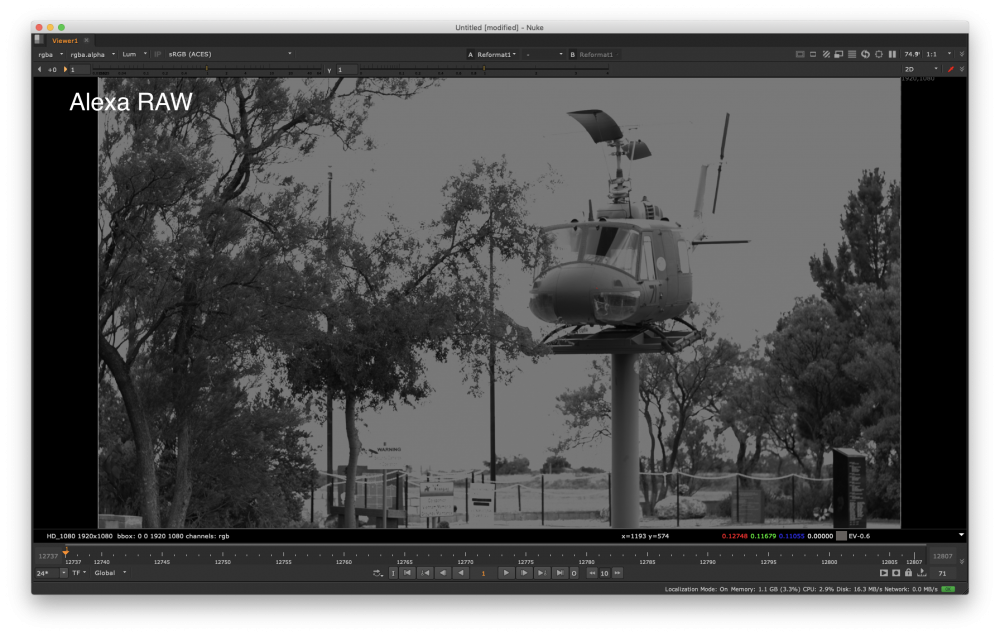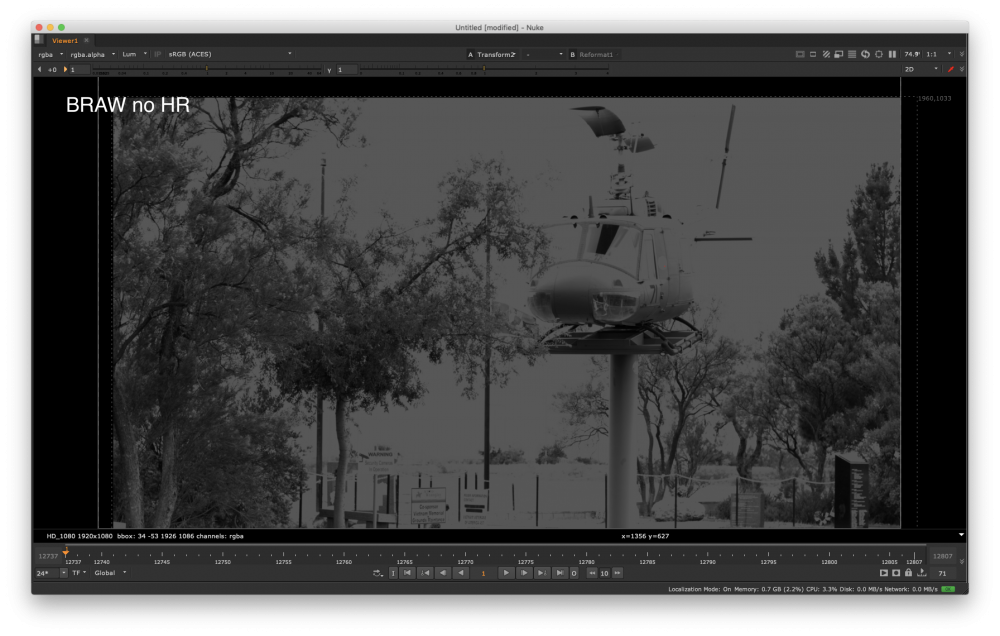
Llaasseerr
Members-
Posts
347 -
Joined
-
Last visited
Content Type
Profiles
Forums
Articles
Everything posted by Llaasseerr
-
I can't speak for S-gamut3.cine, but just a note on S.gamut3. It is a very large gamut like Arri Wide Gamut and if not handled properly in post, it will clip. You need a big enough bucket and a smart gamut transform to your viewing device that deals with the edges in an aesthetically nice way. Recent ACES developments in this area is one example. If you just randomly grade Slog3 for Rec709 output, it will be more likely to clip. Part of the issue is also that software like Premiere is really only designed for Rec709, so this needs to be done in Resolve. This clipping issue is fallout because camera manufacturers put industry-level tools into consumer cameras but the workflow is not explained. We all benefit form this democratization though.
-
We'll soon know what they are thinking. For interoperability with the FX line, at minimum true 24P and I suspect DCI will be required.
-
PRR is not redundant because it does not subsample chroma information. It's also 12 bit log (EDIT: on the Sony cams) vs 10 bit and has less compression artifacts than an internally recorded h.265 type of codec that's really designed for final exhibition, not for capture. Of course, this may not be important to your particular situation. These baked colour latitude tests do not really show very much because they do not reflect the original sensor captured image. In addition, any DP that needs to correct footage that was incorrectly exposed by more than 3 stops should be fired.
-
This actually makes me hopeful about whatever Sony is intending with the FX3 since clearly it's not just the "a7sIII with S-Cinetone" as some have stated.
-
Thanks, I'll take a look. I have total respect for 3DE. Germans being precise about stuff.
-
Tbh from my experience working with a lot of handheld Alexa footage, the CineD estimate for the XT in I assume 2880 seems more credible (around 3ms). I've worked with a lot of open gate XT footage and it did not look like 13ms either. But I didn't measure it, so ? The only time I've noticed artifacts is with strobe lights. With the 65, I've seen whip pans def have more of a diagonal though. But still only ~10ms in my estimation.
-
Tbh from my experience working with a lot of handheld Alexa footage, the CineD estimate for the XT in I assume 2880 seems more credible (around 3ms). I've worked with a lot of open gate XT footage and it did not look like 13ms either. But I didn't measure it, so ? The only time I've noticed artifacts is with strobe lights. With the 65, I've seen whip pans def have more of a diagonal though. But still only ~10ms in my estimation.
-
I'm really talking about underexposing in order to push the highlight detail, that's my agenda though haha. You'll get a stop more highlight detail by pushing a stop. Two stops more by pushing two stops. Shadows will obviously suffer a bit. I haven't checked if the LF rolling shutter is worse than the original sensor size. But even with the a7sIII sensor being 4x slower, it's still fast enough - sub 10ms for a full frame sensor is quiite nice. I know a lot of people aren't that concerned by rolling shutter, but I think it's really important. I look forward to when we are all using global shutter with no DR penalty. EDIT: I didn't see the published RS speeds, thanks @androidlad
-
Thanks, I should download some footage from this cam and take a look. And I definitely like the highlight recovery tool, I've used it on DNG frames back in the day. What you seem to be suggesting is pushing the DR by +1 stop to protect highlights, ie. push native 400 to 800, which I definitely do with an ND quite often. Noisier, but manageable shadows ("texture"). But then if you were fair and did that with an Alexa, which is totally doable, it would be back to the same margin of difference between the cameras. Overall, as I stated I'm most hopeful about the current Sony sensor. Where it beats the P6K is rolling shutter performance, by a fair amount. But it's still about 4x slower than the Alexa.
-
Yeah, we should not need raw to record a clean signal without NR, etc - agreed. Personally I liked the fact you can record 444 12 bit log ProRes with the early Alexas but it never trickled down to the mirrorless cams. Needing raw and the external device is a pain, but I'll take it haha. It depends on project requirements. It's just abut manageable at this point. I can afford the extra time to squeeze out more quality. I hope RED's stupid patent dies though. I hear you on the Ursa. I've never been that convinced. They always seemed to just be fixing sensor issues. with each update. I'l admit I haven't paid that much attention to the Pocket 6K because of rolling shutter and the form factor. The a7sIII/FX6/FX3sensor is probably where it's at for me right now.
-
Unless I'm misunderstanding you, I'm not sure how to quantify that it has more shadow and highlight information, but less dynamic range because basically it's the same thing. If you have some comparison frames in BRaw or log, I'd be interested to take a look. I guess it's important to state that there's DR above and below middle grey, and ask what's the camera's emphasis. For example practically every affordable camera is more about stops below middle grey, whereas the Alexa is more about stops above middle grey. But also the noise it produces in the shadows has a nice filmic look, up to a point. Again, the FX3 raw output should be unmolested but that most likely involves attaching the Ninja V. Yeah, maybe they're adding the FX6 ability to disable NR for internal recording.
-
No worries. Yes, DR is "measuring the brightest and darkest regions that retain detail in an image". However, yes it does also "take into account shadows and highlights that can be recovered in post." This is especially true since we are recording images more and more often as ISO invariant. That's the case with raw, but also if you look at what CineEI log recording is on the Sony FX cams, it's just saying 'we record at the base ISO where sensor DR is maximized, but we will display on the camera monitor with the ISO change you want, and also put it in the metadata". So effectively it's the same as Raw or log at a base ISO. You don't get any more shadows or highlights than what is recorded in that raw or log image, but it's how the data is displayed that has led to the term "highlight recovery". Unless specifically talking about highlight reconstruction, which is where Resolve will synthesize new data from partially clipped channels in the upper range. Basically there's no highlight recovery, it's just a case of bringing certain detail into the normalised 0-1 range that would otherwise not be visible once a raw or log image is converted to display on a Rec709 or P3 monitor. More of this data can be displayed on an HDR monitor. If you look at the linear values a log curve can hold in a normalized 0-1 space, it goes up into double digits with say, S-log3 (about 38.2) or Arri LogC (about 55.0). This represents a way of compressing the raw sensor values into a 0-1 container. When you invert the log curve, you get the full range of raw values again. But you'll only ever be able to see 0-1. So in order to see extreme highlight information, An aggressive filmic S-curve is applied with highlight rolloff, after the fact. That mimics the behaviour of film that can capture very high brightness values, and aggressively compress them in a very aesthetically pleasing way. Also a gamut and gamma transform is applied to comply with the viewing device. That is how "highlight recovery" can bring superbright values back into range on the viewing device compared to a baked image, where all the above transforms have already been applied in-camera (S-Cinetone, etc). If you have set up a proper colour pipeline for your project then you don't need to think about the colour transforms moving forward - so there's no work. The highlights fall where you expect them, but assuming you have enough DR you can still adjust the exposure correctly to bring certain values into range as if you were doing it in camera, and the highlight rolloff will dynamically display correctly based on the final film look LUT that you're applying.
-
To bring this roughly back to the FX3, I just wanted to mention that for me, Assimilate Scratch is a great piece of software for ingesting ProRes Raw from the Sony cams and getting the maximum dynamic range and image quality out of them. It then allows going into Resolve, or Nuke, of course. For my tests, I've exported from Scratch as ACES OpenEXR, which is the biggest bucket possible for dynamic range and wide colour gamut, so I'm confident I'm getting the most the camera has to offer. I accept that other people are probably looking for more convenience, though.
-
For me personally, any ETTR method is not relevant and I'm only interested in exposing for middle grey. Each to their own, though. Also, is there any attempt to bring these images into a common baseline space to compare them, via camera vendor supplied colour transforms? There is no mention in the translated article. And yes, NR is a factor, that is why I would advocate for DR tests without it. Such as ProRes Raw or FX6 with NR "off", compared to an Alexa that does not have NR anyway, and stick to the Arri method for noise floor calculation with the Xyla/IMA tests for consistency. In the end, I can do NR in post with Neat Video or a deep learning method, and get a better result than an in-camera method. I never shoot with NR enabled though.
-
With the caveat that I have not explored the S1 that much and that this is the S1H, and without knowing the specifics of this test, broadly both cameras are capable except the latitude is clearly better on the -2 underexposed ProRes Raw on the S1H. But then if you shift to the higher base ISO on both cameras instead of underexposing to such a degree, would that still be the case? In the end, for similar DR I prefer to have much better rolling shutter on the a7sIII sensor. my take on latitude for my purposes is that it's how much you can recover up or down within the bucket of the dynamic range captured. This is where generally speaking, shooting ISO invariant at one of the base ISOs with the max dynamic range is probably the way you are going to do it whether it's RAW or say, Slog3 CineEI mode. So for me, the latitude is dependent on the total DR as shot at a base ISO. But assuming I've done my job and exposed roughly correctly when shooting - say within half a stop of my intent unless I'm pushing or underexposing - basically I will only want about +/- 2 stops, maybe 3 of latitude for any given exposed image. So the overall DR is a bigger factor. These kinds of tests do not really take wide DR into account for a correctly exposed scene, because they are looking at a grey card/colour chart and typically caucasian skin tones, but generally not at extreme light sources or highlights that would clip the sensor at a give exposure. The daylight Alexa tests shot through the exposure range hosted on cinematography.net are a better example. Shadows though, are probably okay to gauge. But I don't trust that they are moving the exposure up or down in post correctly. I think they are just eyeballing it to match the base ISO image. They really need to do a mathematically correct exposure change in a linear floating point space in order to simulate an ISO/f-stop/ND filter exposure change. As far as this specific test, he has not published his colour pipeline so it's hard to do comparisons. The only thing I know for sure is at one point he shot Prores Raw. But how was it interpreted? What did he capture the non-raw footage as? If log, did he import it correctly for each camera vendor's log type? What LUT did he use as his look final look? Did he do that for both cameras? All the variables need to be removed.
-
I wasn't able to edit this in time, but the "BRAW no HR" image was displaying the red channel, not luminance. So I'm uploading it again, showing luminance.
-
Thanks, I took a look at this and it was a fun test. Okay, I can see that with highlight recovery the Braw has some more detail in the window reflections than the Ari raw. But this was shot +7 stops overexposed, so at best it's only useful as an extreme latitude test where really you would expose correctly when filming and then if needed push it +/-2, maybe 3 stops at most. Both of the images are insanely clipped, there's no sky detail. The issue with using highlight recovery is that it's extrapolating from data that's not really captured and making a best guess synthesis. Sometimes it works, sometimes it doesn't. But it's not a strategy for capturing more dynamic range, which is probably why it's disabled in Resolve by default - even for BM's own cameras. It's more of a neat party trick when combined with extreme overexposure like this. Screengrabs uploaded. The image with the most highlight detail is the Braw with highlight recovery. Without highlight recovery, it has 0.7 stops less in the highlights that the Alexa. If it was even remotely correctly exposed, the Alexa would be holding two stops more detail. Maybe 1.5 if factoring in successful highlight recovery on the Braw. This guy's original comparison method in Resolve is not apples to apples in the way he's treating the footage differently. All I did was import the BRAW into Resolve and export it as a linear ACES EXR both with and without HR. So I'm using BM's own ACES color science for this camera. I then took them into Nuke where I had already imported the Arri Raw through ACES. So this ingest process provide a baseline consistency as far as scene referred light values captured by both cameras. I then lowered the exposure on all three by -7 stops. As you can see from the screengrabs, that brings the exposure into line if you look at the trees and the helicopter as a stand-in for shooting a grey card. The sensor clipping point is the sky and the reflections, to varying degrees. EDIIT: Forgot to mention these screengrabs are captured showing "luminance only" in Nuke, to emphasize the consistent exposure and the highlight differences in each image.
-
Yeah, at this stage it makes more sense to put the WDR feature in the FX6 as a paid update, which was what the original rumor suggested. But it's fun to speculate it may be in the FX3 because it's the same sensor and it has the active cooling system. You never know. Agreed, the DR of the A7s3 is still great. Have you tried shooting raw? No noise then. Plus an extra 2 bits of Slog3, and importantly NO chroma compression. Re: The Pocket 6K, there's no way it can get more DR than the Alexa with highlight recovery if they are both exposed the same. As you say, highlight recovery is also just a synthesis by copying information from one channel to the other two clipped channels. BMD cameras just don't hold up. You can link me to the files if you want, and I'll take a look. I haven't checked the S1, but from the CineD Xyla test it's 12.1 stops which is almost a stop less than the a7sIII unless it's maybe more skewed to clean shadows. Personally, my interest is in the values above middle grey, though. I have checked a lot of cameras seeing if anything is close to an Alexa and consistently nothing is, which just really surprises me considering how old the sensor tech is at this point. Cameras are just getting worse because they are pursuing more pixels, for the most part. But with the a7sIII, Sony actually started to cross the Rubicon which is pretty interesting to me. Hence my interest in where they go with this sensor with the FX6 and the FX3. The way I check DR is that if the footage is not raw, I linearise log plates to linear floating point based on the technical transform provided by the vendor, or I use the vendor's ACES IDT, then I check the max value where the sensor clips. This is easiest to do in Nuke or Scratch, and is a completely unambiguous method.
-
We'll have to see if it materializes. But based on the number of white papers for this method, there is no temporal aliasing which harks back to Red's shitty kludge from a few years ago. As an aside, I checked out the DGO implementation in the Canon cameras and that is also a bit below expectations, so this Sony sensor is to me preferable even in its current incarnation, particularly because of the fast rolling shutter. It's the best DR and rolling shutter in an "affordable" camera right now. But in the end it's only an incremental improvement. It's a welcome, but modest half a stop more than the previous a7s models. The Alexa is capturing two stops more above middle grey than any of the Sony CineAlta cameras, and the difference is huge. Sony is actually gimping their CineAlta camera sensors based on lowering the voltage - I think in order to manage power draw - so that they are only capturing a subset of what the Slog3 curve spec is capable of. This WDR upgrade could address that, but of course it probably requires a higher power draw. In linear light values, two more stops means it captures 4x the light information in the scene. You can't quite appreciate that when looking at a log-encoded curve. After working with Alexa footage for years, anything else is a bit of a disappointment because it needs to be babysat or it needs to be shot underexposed with an ND to get something approaching Alexa/film levels for bright sunlight, fire, explosions or hot specular highlights on cars etc. And then of course you need to denoise the shadows, possibly. It's not deal, but it's workable. Look at how Deakins shoots, he just exposes for a grey card like film and doesn't worry about clipping highlights because there's tons of range. I love the eND in the FX6 but it's just a convenience compared to actually capturing way more brightness information. Of course everyone has their own priorities, though. ✌️👍 There is the option to just use the FX6 and get both features, if the WDR gets rolled out.
-
Definitely low noise due to improved cooling could eke out a little extra effective usable dynamic range before resorting to Neat Video, which will be nice. This latest video continues backing up my thesis of future cool "cinema only" updates via firmware. Although I'd love to see it, I'm doubtful of internal raw due to the Red bullshit patent unless Sony did it via X-OCN and somehow that was permissible. I'm still stanning for the WDR paid firmware update which will in theory turn this and the FX6 into DGO dynamic range beasts.
-
Shooting ProRes Raw with the a7sIII bypasses any processing.
-
Sony isn't like Panasonic where it would put more niche "pro" features into their mainstream cam release. Considering how long they waited before updating to the a7sIII, they put out something great that was probably at the end of the runway for what they could develop at a prosumer price point with passive cooling. They decided to tape it out and release it and it's been a huge success. Development with this sensor continued with the FX6, and now the FX3. Both of which have more headroom to add features via firmware updates due to active cooling (and in the FX6 case, higher power draw). The fact they have been willing to cannibalise the FX9 and even the Venice with the FX6, and by extension possibly the FX3, is very interesting. In fact, the a7sIII/FX6/FX3 sensor has slightly better dynamic range than the Venice and with future firmware updates there is room to push that further with the FX cams. In a linear Open EXR image Venice clips at 11.7, which fits Sony's stated max value of 1300% of 90% white (13*.9=11.7). ProRes Raw with the a7sIII has a max linear value of around 13.0, so slightly more. Overall this is still 2 stops less than Alexa, unfortunately.
-
So far I've seen a number of comments baffled by the additional active cooling. Following on from my previous speculation, this vlogger agrees that this feature could be tied to a cine-camera only firmware update that I personally think would be something not possible with the passively cooled a7sIII, such as the rumored WDR that was touted as a later v2.x paid update for the FX6. Maybe released at the same time as this camera, or if not around NAB? The rumored upgrade was labeled as a v2.x firmware feature, so if it's real then obviously it was not ready at the time of the FX6 release. I of course reserve the right to be completely wrong. To clarify, for the end user WDR would be effectively a form of dual gain output.
-
Yes.
-
Yes, the sensor in the FX6 and potentially the FX3 is more or less the same as the sensor in the a7sIII. But the a7sIII does not have the WDR feature enabled. As for Fuji, I assume you mean the Sony sensor in the GFX100. The dynamic range of this camera is still within the bounds of an X-T3/X-T4, around 12 stops. It doesn't have the particular WDR method enabled that is potentially going to be in the FX6 and possibly the FX3.





